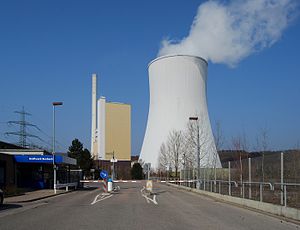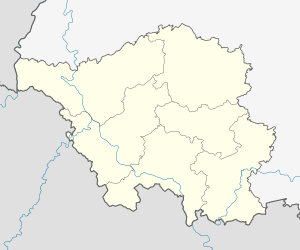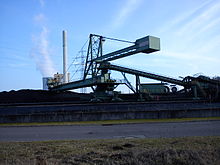Bexbach power plant
| Bexbach power plant | |||
|---|---|---|---|
| Bexbach power plant from the entrance area | |||
| location | |||
|
|
|||
| Coordinates | 49 ° 21 '47 " N , 7 ° 14' 16" E | ||
| country |
|
||
| Data | |||
| Type | Steam power plant | ||
| Primary energy | Fossil energy | ||
| fuel | Hard coal | ||
| power | 726 megawatts | ||
| owner | 75% KBV - Kraftwerk Bexbach Verwaltungsgesellschaft mbH 25% Steag |
||
| operator | Steag Power Saar GmbH | ||
| Start of operations | 01/01/1983 | ||
| Website | www.steag.com | ||
The Bexbach hard coal power plant near Bexbach has an output of 726 megawatts and is the most powerful power plant in Saarland. Up to 200,000 tons of coal can be stored in the power plant's coal store. It produces 2.9 million tons of CO 2 annually ; this corresponds to 920 g CO 2 per kWh. In 2016, the owner Steag applied for the power plant to be shut down for 2017. This application was rejected by the Federal Network Agency and applied again by steag for May 2019.
history
Old systems
A power plant was first built at the Bexbach site in 1953, the St. Barbara I power plant, which burned the low-calorific ballast coal from the newly sunk Bexbach mine. The plant initially only had an electrical output of 110 MW with two turbines. The power generated was in the pit own 65 kV network of Saarbergwerke fed.
In 1957 the construction of the power plant Barbara II began with an electrical output of 150 MW. Commissioning took place in 1960. The electricity customers were RWE . At this time, however, the Bexbach mine had already been closed (1959). The fuel requirement of around 1,200 tons of ballast coal per day had to be delivered by rail and road from other pits of the Saarbergwerke and from private pits.
Both power plants were shut down in 1988 and 1989, respectively. a. because retrofitting according to the specifications of the Large Combustion Plant Ordinance (GFAVO) no longer paid off economically. In addition, the dust and noxious gas pollution in the local area, with increasing environmental awareness of the population, repeatedly led to protests. In 1990 the systems were dismantled. A group of companies from India bought parts of the systems and put them back into service there.
Today's power plant
After the construction of the 656 MW large coal power plant Weiher III in Quiigart , the first of this output size in the Federal Republic of Germany, Saarbergwerke decided to build another power plant block with 726 MW electrical output in order to reduce the production volumes that were no longer going to France due to expiring contracts could be delivered to be converted into electricity in Saarland itself. The target group for the purchase of electricity were the southern German energy supply company Badenwerke (BW), Energieversorgung Schwaben - both today EnBW - and Bayernwerke (BAW) - today E.ON. After extensive negotiations, they commissioned Saarbergwerke with the planning, construction management and operational management of the planned power plant block.
In 1979 the construction of today's Bexbach power plant finally began after the preliminary decision issued on November 16, 1978 pursuant to Section 9 of the Federal Immission Control Act (BImSchG) became legally binding. The power plant went into trial operation on April 1, 1983, and official commissioning took place on October 12, 1983.
The project was highly controversial in public. Several plaintiffs against the immission law approval only withdrew their action when Saarbergwerke made concessions on environmental protection measures that went far beyond those of the approval notice. Two weeks before the official commissioning in 1983, there was a spectacular protest. Two members of the BUND district group Pirmasens climbed the 240 m high chimney on October 1, 1983, unrolled a banner with the inscription "Baumkiller" and occupied the chimney for eight hours. In a declaration they protested against the environmental pollution they believed to be expected and the pollutant separation measures that were not in line with the state of the art. This was one of the first such protest demonstrations against a large coal power plant in Germany.
The plans for a second power plant block at the site were given up in 1996 after many years of resistance, especially from communities in the West Palatinate.
The operator of the Bexbach power plant is Steag Power Saar GmbH . This is the legal successor of Steag Saar Energie AG. The power plant itself is 75 percent owned by KBV - Kraftwerk Bexbach Verwaltungsgesellschaft mbH (shareholders 33.3 percent Evonik New Energies GmbH and 66.6 percent EnBW Kraftwerke AG ). Other shareholders were Stadtwerke Aachen AG (Stawag) with 16.66 percent and E.ON Kraftwerke GmbH with 8.34 percent . EnBW acquired the E.ON stake in 2009 and, with effect from October 1, 2009, also the 16.7 percent stake in Stawag Energie GmbH (Aachen). EnBW now had 714 MW of installed capacity in Bexbach and extended its electricity purchase rights to 100 percent. The power plant is now completely owned by Steag.
An application for co-incineration of sewage sludge was rejected by the Saarland Ministry of the Environment at the end of 2003. In a press release by the ministry on January 1, 2004, it said that the application would be rejected because neither the immission control requirements according to Section 6 (1) No. 1 nor the other public law permit requirements according to Section 6 (1) No. 2 BImSchG were met . After obtaining an expert opinion from TÜV SÜD, the ministry came to the conclusion that the permissible limit values for mercury could be exceeded if sewage sludge was incinerated. In addition, neither the city of Bexbach nor the district administrator of the Saar-Palatinate district had the building approval . A lawsuit by the applicant against the decision of the licensing authority before the Saarland Higher Administrative Court was unsuccessful. A revision was not allowed.
The grid connection is made via the Mittelbexbach switchgear at the 380 kV maximum voltage level in the Amprion grid .
In December 2016, the energy company Steag commissioned large battery storage systems with a capacity of 15 megawatts at the Bexbach power plant. Steag invested 100 million euros in a total of six locations in North Rhine-Westphalia and Saarland.
See also
Individual evidence
- ↑ a b c power plant list of the Federal Network Agency , as of March 7, 2019
- ↑ Steag switches off coal-fired power plants . In: n-tv , November 2, 2016. Accessed November 2, 2016.
- ↑ steag press release from April 26th, 2018
- ↑ https://www.enbw.com/unternehmen/presse/pressemitteilungen/presse-detailseite_82560.html



